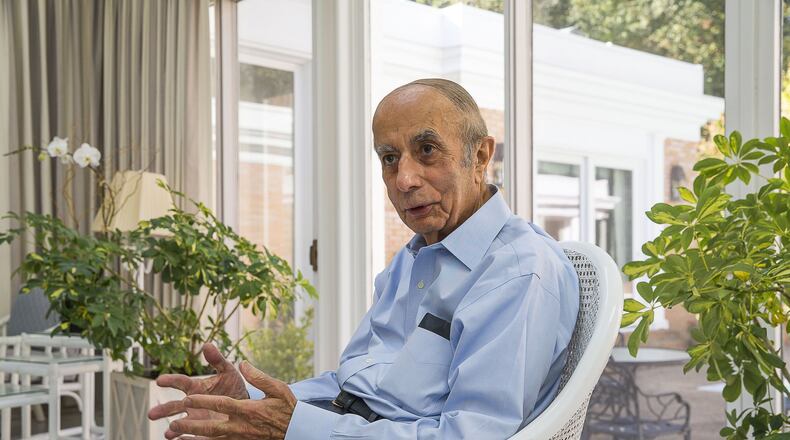Most of the walls are bare at the Shaheen house north of West Paces Ferry.
The gallery lighting is gone, and the anti-theft devices have been removed, the faded spots painted over with a new coat of creamy beige.
In the meantime, the walls are filling up at the High Museum of Art in the Stent Family Wing, where a brace of impressionist paintings by Monet, Pissarro, Renoir, Matisse and others will go on exhibit later this month.
Shouky and Doris Shaheen have been enjoying these paintings for 30 years or more. Now, they say, it’s time for the rest of the city — their home for more than five decades — to have a turn.
"The museum needs paintings," said Shouky Shaheen, "so we're adding 24 more."
The Shaheens have been collecting impressionist and post-impressionist art since the 1970s and hanging it on the walls of their 1960s-era one-story home, which is not far from Rembrandt Road.
When Claudia Einecke, curator of European art at the High Museum, traveled to the Shaheen house earlier this year, she had the dizzying experience of walking through a normal, cozy, family home, except that the works of European masters were shining from every vertical surface.
"You could sit there and be stretched out on the sofa and look up and look at a Monet," she said. "To have these paintings in this very domestic, intimate kind of setting, well it has its own charm."
Einecke said the Shaheen collection, which goes on display at the Doris and Shouky Shaheen Gallery in the Stent Family Wing Nov. 22, will more than triple the High’s holdings of impressionist paintings.
And Shouky Shaheen isn’t done. “There’s still some holes in this collection,” he said. “I’m going to try to fill them up.” He’d rather not say which auction he’s soon participating in, but suggests “I’d like to get another Renoir.” For the High.
Recently Shouky Shaheen took a day off work to give a brief tour of the few paintings left in his house, including portraits of his wife, Doris, their children, Bill and Mary Gay, and a few landscapes by Andrew Wyeth and Jamie Wyeth.
At age 90, Shaheen has been retired from his real estate development business, Shaheen & Co., for two years, but he still drives himself to the office most weekdays, in case his son Bill, the president, has any questions. Mostly, he says, Bill runs the show.
Shouky was dressed in his usual attire, a sharply pressed Brooks Brothers shirt, dark slacks and Gucci loafers. If he goes out, he will add a jacket and tie, though he notices that most Atlantans are far more casual.
Doris was recuperating from a broken hip at the Lenbrook senior community in Buckhead. Shouky was eager for her to come home, but she must graduate from a walker to a cane before she can leave Lenbrook.
Among the few pictures on the walls at the Shaheen house is a fake Picasso — a copy of a portrait of Marie-Thérèse — that tells a story about Shaheen’s collecting life.
Shouky studied the history of art at the University of Chicago, but he and Doris didn’t start buying until the 1970s.
Their first serious purchase was from an Atlanta dealer, a work by the Fauvist artist Maurice de Vlaminck.
“I sent it to New York to see if it was authentic, and it was, but I paid $34,000 for it, and the retail value up in New York was $12,000 to $14,000. So that’s my first experience with dealers.” Another dealer in New York sold him a fake Mary Cassatt, generating a conflict that was finally settled in court.
But after he and Doris turned to the auction houses in New York, their experiences improved. He often bid by telephone, and always set a limit above which he wouldn’t go.
Shouky has very rarely sold any of his paintings, pursuing a “buy and hold” philosophy. In 2012, he decided to put a Picasso up for sale at one of the New York City auction houses. The painting, a portrait of Marie-Thérèse, was expected to sell for $20 million. Then Hurricane Sandy came to town, and attendance at the auction was a fraction of the usual. The price hardly budged from the opening bid of $15 million.
On the other hand, Shouky bought the painting decades earlier for about a half million, so he still came out ahead. Sotheby’s gifted him a copy of the painting, as a thank-you for using their services, but they won’t do that these days, he said. They don’t want to add to the supply of fakes.
A complicated path led Shouky to Atlanta.
His father, Azeez Shaheen, was born in Ramallah, Palestine, and came to Brooklyn in 1913, where he met his future wife, Saleemeh. She herself had immigrated to the U.S. from Nazareth.
Azeez sold Oriental rugs in Chicago, where Shouky Shaheen and his three brothers were born. Shouky attended the University of Chicago, earned a bachelor’s degree, then graduated with an MBA in 1953.
By then the elder Shaheen had pursued the carpet business in Dalton, Georgia, and Shouky followed his father there, first learning the carpet business, then starting his own enterprise, building textile mills and shopping centers.
He also met his future wife, Doris Bradshaw, in Cartersville, on a blind date suggested by his bookkeeper.
The two moved to Atlanta in 1965 and built a house off West Paces Ferry, in what was then the northern edge of the city. (After his wife Saleemeh died, Azeez Shaheen moved back to Ramallah, where he lived to age 102, and, into his centenarian years, continued to give Shouky stock market tips.)
Shouky and Doris raised two children, grew a business and dived deeply into the community. After Doris dealt with breast cancer in 1990, Shouky funded the Doris Shaheen Breast Health Center at Piedmont Hospital, which opened in 2004.
In 2007, Doris surprised her husband by funding the Shouky Shaheen Lecture series, which brings artists and scholars to the University of Georgia’s Lamar Dodd School of Art.
Shouky, who was born in 1929, on the eve of the worst depression in U.S. history, has become a canny businessman by facing subsequent economic tremors with equanimity.
Shaheen and Co. is a real estate development firm that specializes in modest-sized warehouse space, renting to tenants who need anywhere from 1,600 to 10,000 square feet.
“You know the REITs (real estate investment trusts) took over the big warehouse business. They don’t do anything but 100,000 and 200,000 square feet, so it’s difficult to compete with them.”
On the other hand, he said, the big warehouses don’t want business from those renting 2,000 square feet “because that would look like a bowling alley in there.”
Shaheen and Co. takes care of those customers, about 700 of them, and currently owns and manages about 5 million square feet of distribution centers and business parks.
When he started in Atlanta, in 1965, business was nothing but go-go, until 1972. Then, from 1972-1977 it went the other way. “From 1965 until today, I’ve been through five recessions,” he said one day recently at his offices on Cumberland Boulevard. (His outfit: Brooks Brothers shirt, dark slacks, Gucci loafers.) “After the first one, recessions don’t bother me as much.”
You can’t tell what will happen to the beautiful things you buy. The Shaheens’ living room is accented with a beautiful Persian rug in cool tones of silver, gold and gray; the 19th-century coffee table is set with a silver tea service; there are Chinese porcelains, a grandfather clock. But nobody wants brown furniture, said Shaheen. The market for Oriental rugs “has tanked,” and silver and porcelain and grandfather clocks are out of style.
Among the beautiful things in the Shaheen house, the one thing that has appreciated is their art.
That art will now be on display elsewhere. This fall, Shouky had a heart valve replacement, though you’d hardly know he’d been to the hospital by looking at him. He and Doris promised the children they would give the art to the High while they were still alive, and this year, considering her broken hip and his quirky heart, looked like a good time.
The collection will be on display for the next five years at the Doris and Shouky Shaheen Gallery, in the Stent Family Wing of the High Museum of Art.
Rand Suffolk, director of the High, said the collection complements the High’s holdings.
“We anticipate it’s going to feel right at home.”
Snapshot of the Impressionist Paintings
•Jean-Baptiste-Camille Corot, “La bohemiènne à mandoline assise” (ca. 1860s-1870s) is a portrait of a young girl holding a mandolin.
•Henri Fantin-Latour, “Grand bouquet de chrysanthèmes” (1882): A still-life of flowers.
•Henri Matisse, “Femme assise devant son piano (Marguerite)” (ca. 1924): An oil on canvas, this is a study for a larger painting by Matisse. It’s one of two works by Matisse included in the gift.
•Amedeo Modigliani, “Portrait de Beatrice Hastings” (1914) is the first Modigliani to enter the High’s collection.
•Camille Pissarro, “Paysanne assise” (1882): One of three works by Pissarro included in the gift, this one features a portrait of a peasant woman.
•Alfred Sisley, “Une rue à Marly” (1876): There are four Sisley paintings in the gift; including this landscape.
•Claude Monet, “Maison au bord de la route” (1885) is one of three paintings by Monet in the collection.
About the Author
Keep Reading
The Latest
Featured






